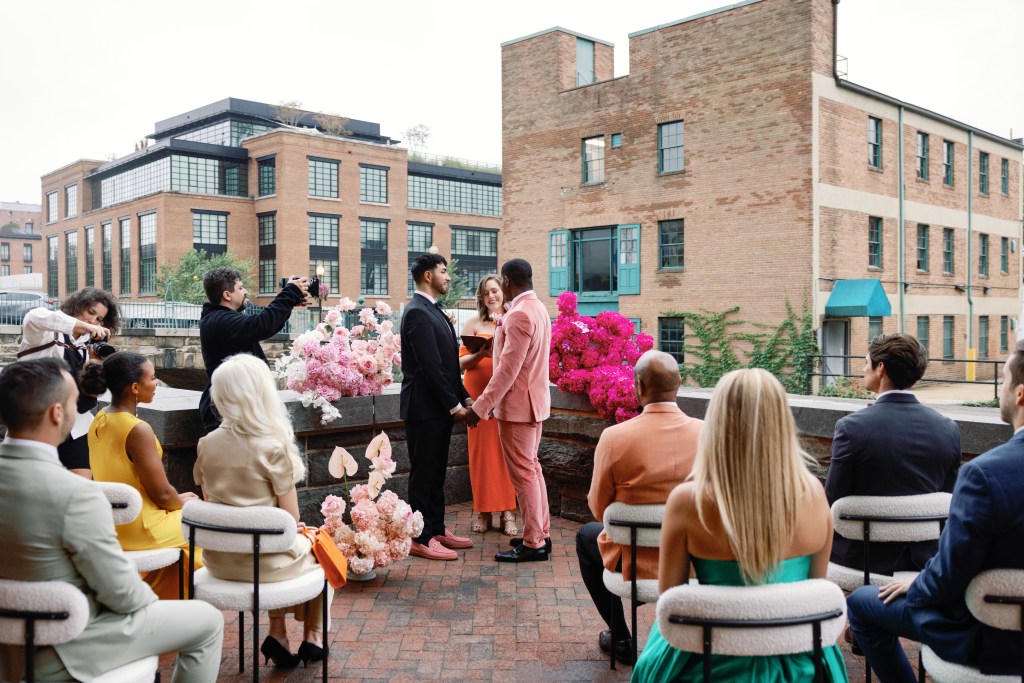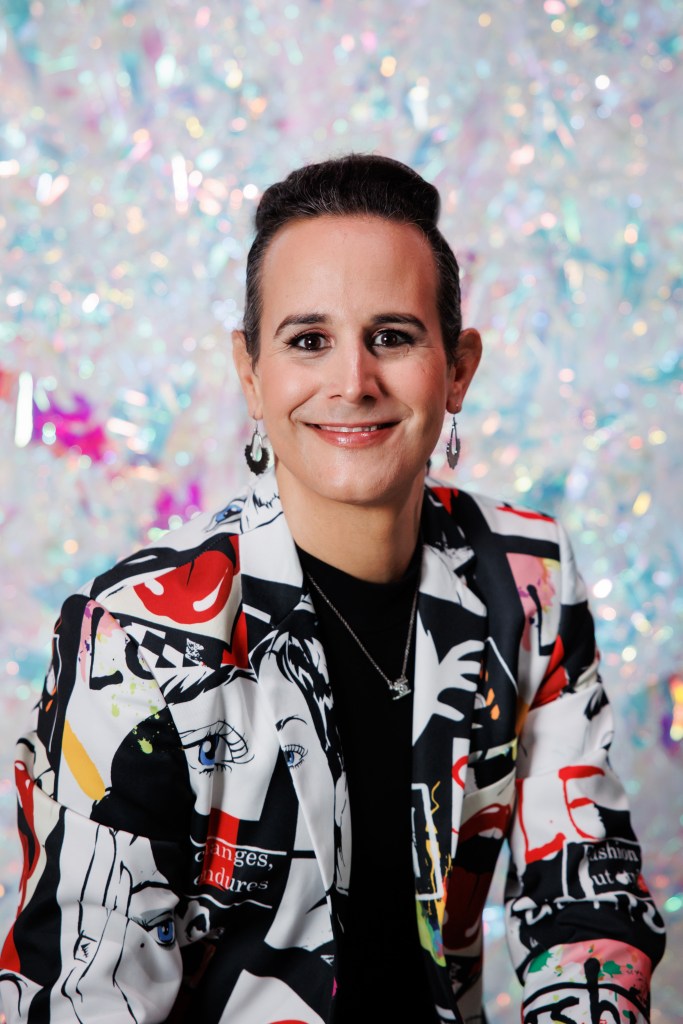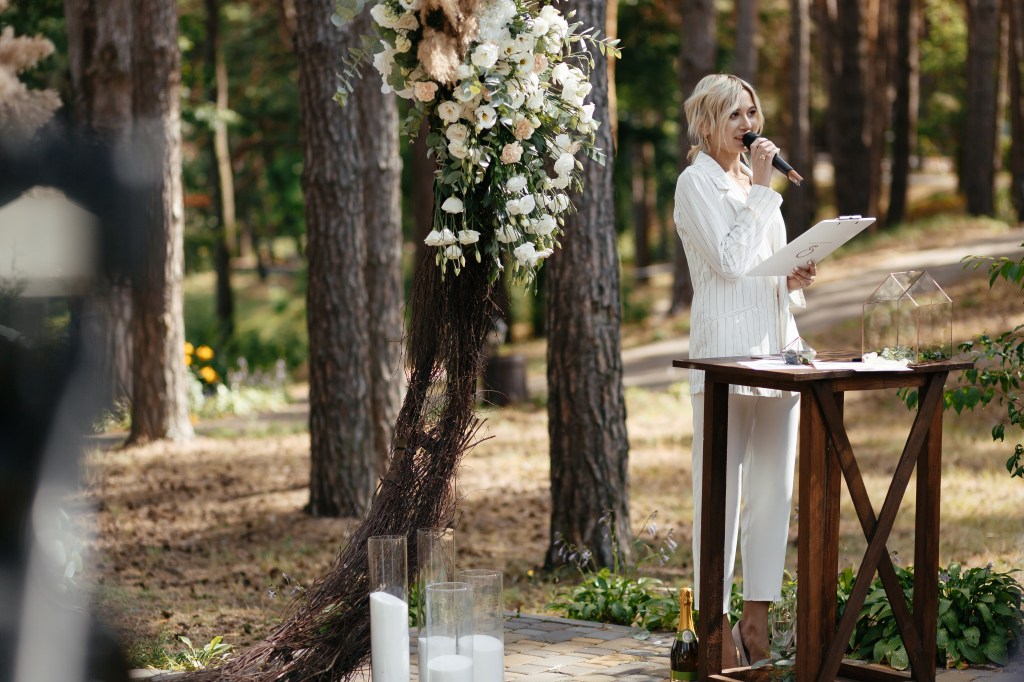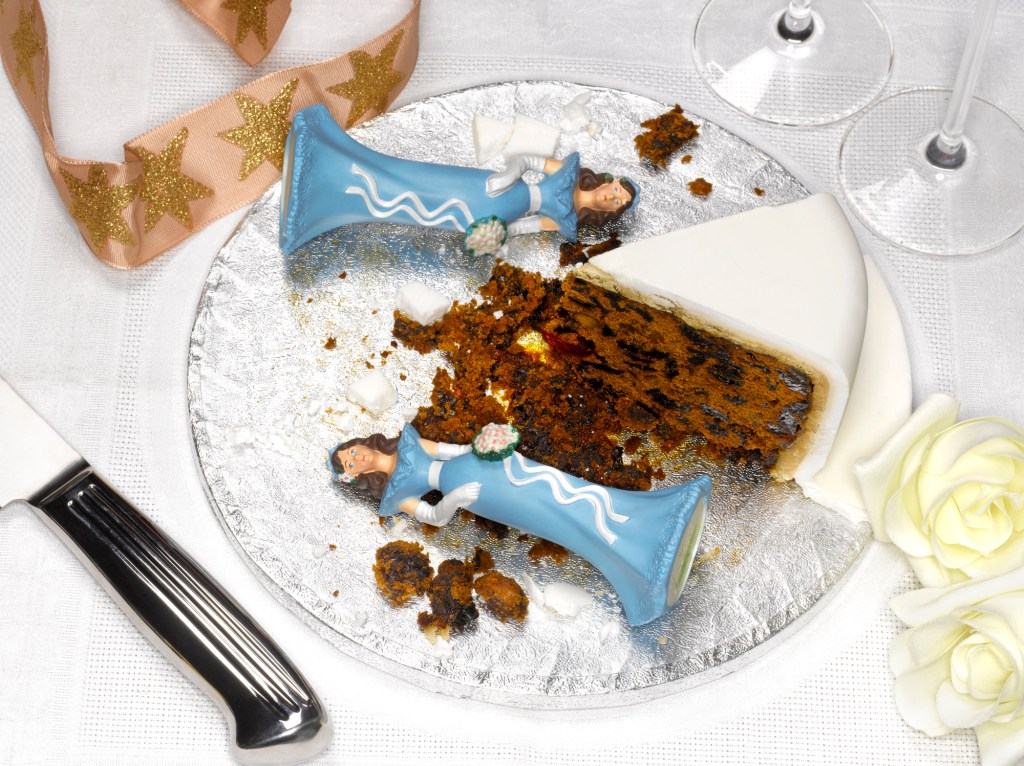Your Top LGBTQ Wedding Terminology Questions Answered

I love summer. Seventeen years ago on a warm summer evening on a balcony 33 stories above the city of Dallas, I met Emily. We were married two years later in what could have been a beautiful LGBTQ wedding, but I was still in denial and unable to conceive of a world in which I could be my authentic self.
Now that I have accepted and embraced my nonbinary gender identity, our LGBTQ wedding would be a queer celebration of commitment between two people that love each other unconditionally and without capacity.
I’ve come to learn that even If you’re an ally of the LGBTQ community and familiar with LGBTQ weddings as an industry professional, some of what I just said may be foreign or confusing. That’s likely because sexual orientation and gender identity are not the same thing, and most wedding professionals are more familiar with sexual orientation than they are gender identity.
In today’s beautifully complex world, not only can you no longer assume that there is one bride and one groom in a wedding, you can no longer assume that there is a bride or groom in the wedding at all.
So, what does this mean for you as a pro? You’ve got questions and we’ve got all the answers to ensure you are up to date on all things LGBTQ weddings.
LGBTQ Wedding Terminology
Ever Changing and Ever Growing
Wedding industry professionals committed to LGBTQ wedding inclusivity accept that language is fluid. New terms are frequently introduced to accommodate an ever-growing society. Additionally, how existing words are used can change over time.
Definitions evolve and adapt to serve society’s needs. It can feel like a challenge to keep up, but it’s totally worth it when you consider how new terms and different uses can help everyone feel represented, seen and welcomed. I’m excited to share recent examples of changes and additions to language that impact LGBTQ weddings and, more specifically, diversity and inclusivity.
Gender & LGBTQ Terminology
- Gender Identity: Who someone knows themself to be in their head and in their heart. Examples include: man, woman, transgender, nonbinary and agender. You can learn more about gender identity in the wedding industry here.
- Gender Expression: How someone chooses to share their gender identity with the world (someone’s choice of clothing, accessories, hair style, makeup, etc.)
- Sexual Orientation: Who someone is physically, mentally, emotionally and romantically attracted to. Examples include: heterosexual, homosexual, bisexual and pansexual.
- Sex Assigned at Birth: What someone is assigned when they are born based on their anatomical parts.
- Cisgender: Someone whose gender identity matches their sex assigned at birth.
- Transgender: Someone whose gender identity does not match their sex assigned at birth (often considered an umbrella term for identities such as nonbinary, genderqueer, gender fluid and gender nonconforming).
- Queer Weddings: Queer is considered by many to be an umbrella term that represents anyone or anything that is not a cishet (cisgender and heterosexual) celebration. Because some labels can be narrow and restrictive, this is a beautiful way to recognize that someone is a part of the LGBTQIA2S+ community without misidentifying them. This term has been used as an insult or slur in the past and may be triggering and not preferred by some people. However, queer has been reappropriated by many in the community, and many are proud of this identification. Ultimately, don’t be afraid to use it if your intention is to affirm them in an effort to increase inclusivity. Should you come across someone that doesn’t prefer you use it, you can simply ask them what they do prefer. Enter these interactions with an open heart and an open mind and remember that this is true of any word, term or label.
- Same Sex Weddings: We’re migrating from the use of gay weddings to the more inclusive term same sex weddings because it does a better job of representing a variety of sexual orientations.
Using Inclusive Language
Now that you have a better understanding of some of the terms and definitions associated with LGBTQ Weddings, let’s consider why you want to use them.
The why is pretty simple: LGBTQIA2S+ people exist, they matter and they deserve to be seen, understood and respected. Tragically, we almost never see ourselves represented in society, and that includes the wedding industry. However, with just a little work and commitment to inclusivity, diversity and representation, you can show the LGBTQIA2S+ and queer community that you see, understand and respect them all with glorious LGBTQ wedding celebrations.
You can start by not assuming the identity or sexual orientation of your inquiries and prospects. Although cishet weddings are more common than same sex and queer weddings, it’s best to never assume anything based on limited information, appearance or expression. You can get things started off on the right foot with inclusiveness and by asking important questions.
Here are some best practices that will immediately make a difference:
Avoid performative efforts.
One of the least productive and potentially offensive outcomes is performative efforts or what is often referred to as “checkbox diversity & inclusivity”. As you educate yourself on LGBTQ weddings, quickly put what you learn to work in your business and in your life. Learning is only the beginning, action is how you really move the needle.
Pronoun usage.
Include pronouns everywhere you can by using them in your email signature, on your social media profiles, in your website bios, on your business cards and in any other location your name appears digitally and in print. You also want to ask for people’s pronouns on all your inquiry forms and questionnaires.
Finally, if your first interaction is over the phone, on Zoom or in person, be sure to offer your pronouns and ask for theirs. By including your pronouns in your business communications, you are making it abundantly clear that you understand the importance of gender identity and support and respect everyone. This is especially affirming to nonbinary, queer and gender nonconforming people.
Welcome everyone (in communication).
If you truly want to welcome everyone, it’s important to ensure the gender and sexuality of your wedding customers is not assumed and that your services are open to all. This means that gender and sexuality get to be open and accurate in your LGBTQ Wedding marketing language, contract verbiage and throughout your relationship with your customers.
Does your language consistently reference the bride and the groom? If so, this is a huge and damaging assumption that is dismissive of and can be triggering to same sex and queer wedding customers. By using gender neutral language, at least until you can be sure how each of your clients identify, you create space for everyone to be seen and welcomed.
Once you know the identity and sexuality of your clients, you can properly identify them in all communications and interactions going forward. It’s remarkable how unique, special and beautiful each of us and our weddings are.
Welcome everyone (in practice).
Remember how I said that learning is only the beginning and it’s action that really moves the needle? Now’s the time to think about how you can put what you just learned to work.
If you own or manage a wedding venue, are you preparing rooms labeled for the bride and the groom? This will likely not be appropriate for LGBTQ weddings. Instead, consider giving them a gender neutral name in alignment with your brand or your locale (like the Pine and Aspen rooms if the venue happened to be in Colorado).
You can always have simple, elegant and beautiful hanging signs created to more specifically identify who will be using that room on the wedding day. Think of how special the guests will feel when you have a sign that is specific to their identity.
If you own a dress shop or specialize in hair and makeup artistry, are you prepared to welcome all gender identities to shop in your store or as a MUA services client? All this to say that when you welcome LGBTQ weddings, you may have a wedding with two brides or a wedding with two grooms, or you may just have a wedding with no brides or grooms. Oh, and you may very well have a wedding with a bride and a groom where the bride will be wearing a stately tux and the groom will be wearing a gorgeous wedding gown. I’m pretty sure that when we renew our vows, I will be finding THE dress and Emily will be rockin’ a tux. The possibilities are endless.
5 FAQs About LGBTQ Wedding Terminology
I know that this may very well seem a bit overwhelming. So, if you’re feeling overwhelmed, just take a beat and review some of these frequently asked questions about LGBTQ wedding terminology.
1. Do LGBTQIA2S+ couples typically have a “Bride & Groom”?
As we discussed above, in regards to your LGBTQIA2S+ clients, you can no longer assume that there is one bride and one groom or even that there is a bride or groom in the wedding at all. Every couple is different and it’s best to use gender neutral and inclusive language until you know how each of your clients identify.
2. What is the correct term to use for same-sex couples?
Instead of focusing on using a term, it’s best to adhere to the gender neutral language guidelines outlined above until your clients have shared how they identify. Remember that what matters most is to make everyone feel welcome, seen and understood.
3. What is the meaning of a queer wedding?
A queer wedding is a term that represents a wedding that is not a cishet (cisgender and heterosexual) celebration.
4. What does “queer” mean, and should I be using it with my couples?
Remember that queer is considered to be an umbrella term that represents anyone or anything that is not cishet (cisgender and heterosexual). While it was used as an insult or slur in the past, the word queer more recently has been reappropriated by many in the community, and many are proud of this identification. If you have clients who prefer for you not to use it, simply ask them about their preferences and honor them.
5. What language should I use in my contracts to be more inclusive?
To learn more about how you can make your contracts more inclusive to your LGBTQIA2S+ clients, check out this article on how to begin changing your contract language to make them more inclusive.
Endless possibilities can be equal parts exciting and daunting, but remember that in reading this article, you’ve taken a step toward increased inclusivity and acceptance through education and understanding.
You refused to allow ignorance to be an excuse, and you’re committed to a zero-tolerance policy for intolerance. People who proudly self identify show you that it’s possible to love yourself unconditionally and what the world can be. When you treat us with respect and with affirming words and actions, you show us a world grounded in acceptance, belonging and care.
If we think in terms of togetherness and connection, we can create a more loving and beautiful world. And, in the end, isn’t that what weddings are all about: connection, togetherness and love?

This post was written by speaker and coach, Don Mamone.
Don Mamone’s decade-long career in hospitality culminated with their role as the Director of Events at the prestigious Beverly Hilton. Determined to embrace their creativity and pursue the dream of entrepreneurship, Don and their wife Emily opened a photography studio and have exceeded the expectations of their loyal clients from Dallas to Destinations around the world for over fifteen years.
As a speaker and coach Don teaches audiences and clients how to reach their maximum potential and impact by discovering and embracing their true identity. Having recently come out as non-binary, Don is a committed advocate for the LGBTQIA+ community and consults with companies and organizations dedicated to diversity, inclusivity and representation as well as creating safe spaces that support and encourage unapologetic authenticity.
When they are not traveling the world for creative projects and speeches, Don lives happily outside the gender binary in Dallas with their talented spouse Emily and their creative child Frankie. To learn more or to ask Don about other ways to make your business more inclusive, you can reach them on Instagram @donmamone.
Photo Credit: Emily Mamone
Let's grow your business together!
Start advertising on The Knot and WeddingWire, the top two wedding planning platforms.


